.
| squib |
reference |
DOI |
| 1973Kud/Rao:140 |
Kudchadker and Rao. Infrared Spectra & Normal Vibrations of Isomeric Triazoles. Indian J. of Chem. Vol. 11. pgs. 140-142. |
|
| 1975Bol/Bro:261-266 |
K Bolton, RD Brown, FR Burden, A Mishra "THE MICROWAVE SPECTRUM AND STRUCTURE OF 1,2,4-TRLAZOLE" Journal of Molecular Structure, 27 (1975) 261-266 |
10.1016/0022-2860(75)87034-7 |
| 1987JIM/ROU |
Jiminez, P.; Roux, M.V.; Turrion, C., Thermochemical properties of N-heterocyclic compounds. I. Enthalpies of combustion, vapour pressures and enthalpies of sublimation, and enthalpies of formation of pyrazole, imidazole, indazole, and benzimidazole, J. Chem. Thermodyn., 1987, 19, 985-992. [all data] |
10.1016/0021-9614(87)90045-0 |
| 1987Kuchitsu(II/15) |
Kuchitsu (ed.), Landolt-Bornstein: Group II: Atomic and Molecular Physics Volume 15: Structure Data of Free Polyatomic Molecules. Springer-Verlag, Berlin, 1987. |
|
| webbook |
NIST Chemistry Webbook (http://webbook.nist.gov/chemistry) |
10.18434/T4D303 |









